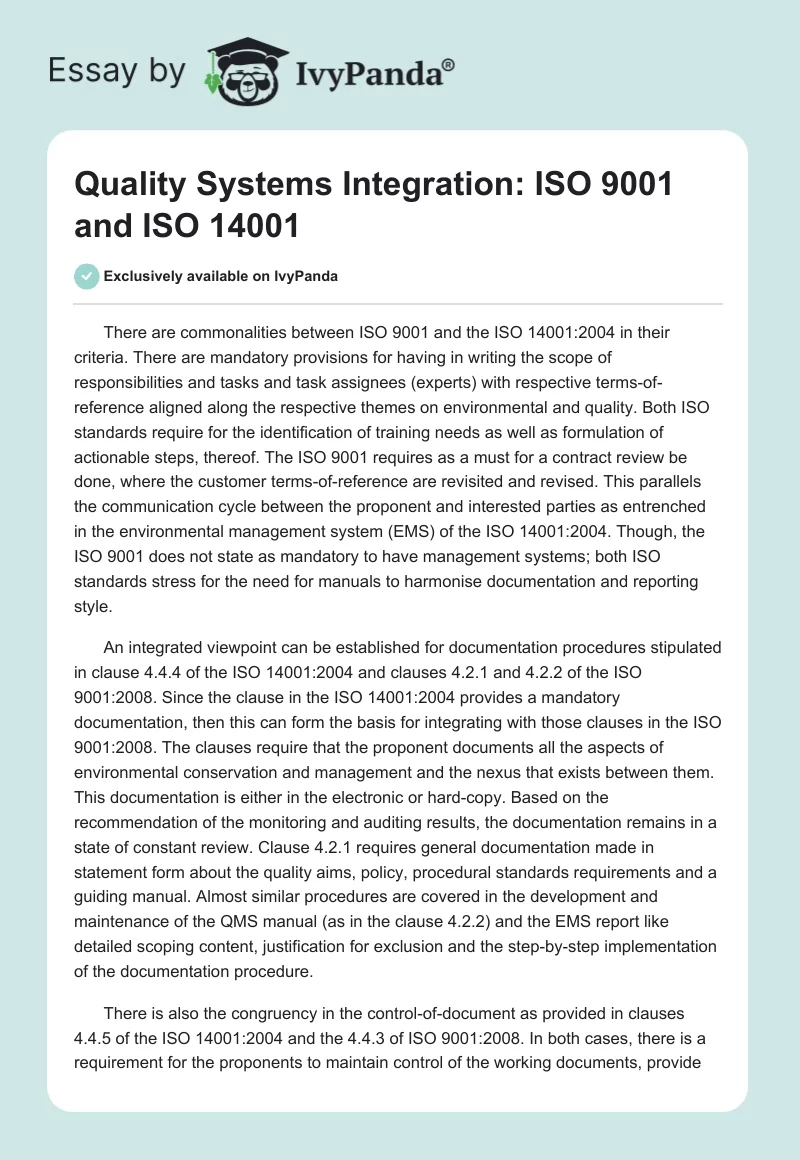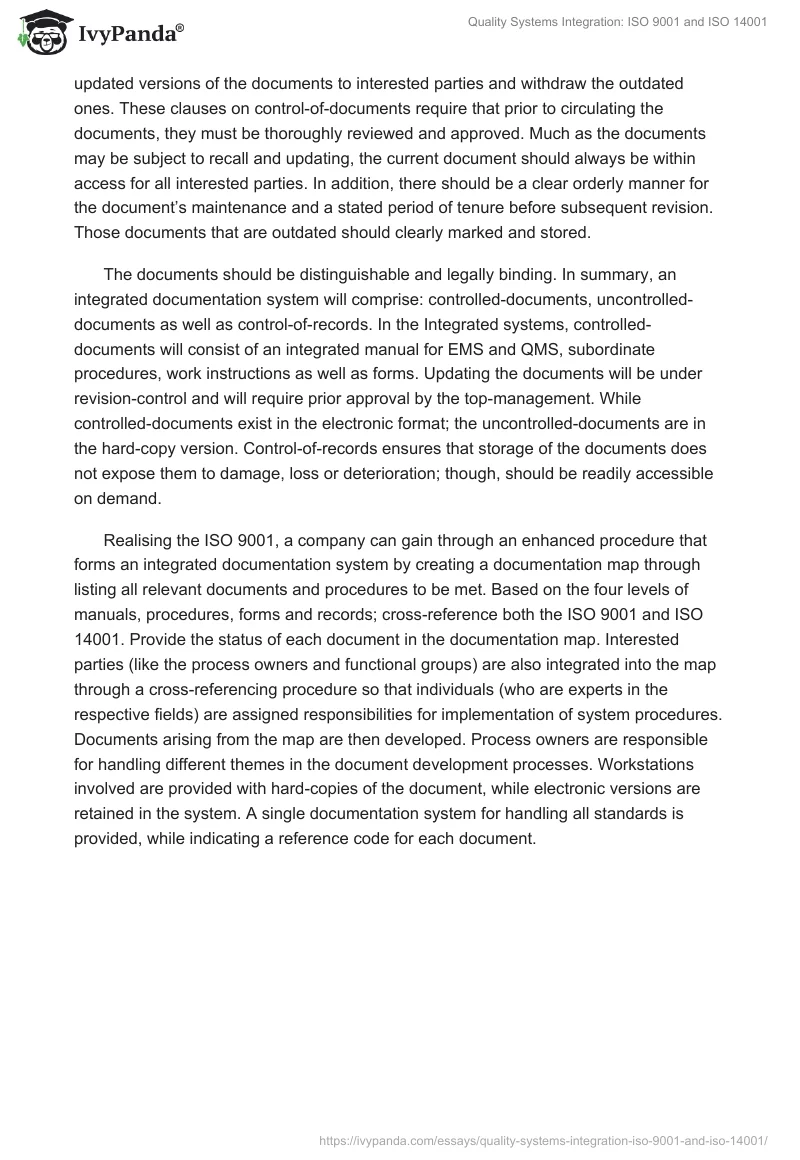There are commonalities between ISO 9001 and the ISO 14001:2004 in their criteria. There are mandatory provisions for having in writing the scope of responsibilities and tasks and task assignees (experts) with respective terms-of-reference aligned along the respective themes on environmental and quality. Both ISO standards require for the identification of training needs as well as formulation of actionable steps, thereof. The ISO 9001 requires as a must for a contract review be done, where the customer terms-of-reference are revisited and revised. This parallels the communication cycle between the proponent and interested parties as entrenched in the environmental management system (EMS) of the ISO 14001:2004. Though, the ISO 9001 does not state as mandatory to have management systems; both ISO standards stress for the need for manuals to harmonise documentation and reporting style.
An integrated viewpoint can be established for documentation procedures stipulated in clause 4.4.4 of the ISO 14001:2004 and clauses 4.2.1 and 4.2.2 of the ISO 9001:2008. Since the clause in the ISO 14001:2004 provides a mandatory documentation, then this can form the basis for integrating with those clauses in the ISO 9001:2008. The clauses require that the proponent documents all the aspects of environmental conservation and management and the nexus that exists between them. This documentation is either in the electronic or hard-copy. Based on the recommendation of the monitoring and auditing results, the documentation remains in a state of constant review. Clause 4.2.1 requires general documentation made in statement form about the quality aims, policy, procedural standards requirements and a guiding manual. Almost similar procedures are covered in the development and maintenance of the QMS manual (as in the clause 4.2.2) and the EMS report like detailed scoping content, justification for exclusion and the step-by-step implementation of the documentation procedure.
There is also the congruency in the control-of-document as provided in clauses 4.4.5 of the ISO 14001:2004 and the 4.4.3 of ISO 9001:2008. In both cases, there is a requirement for the proponents to maintain control of the working documents, provide updated versions of the documents to interested parties and withdraw the outdated ones. These clauses on control-of-documents require that prior to circulating the documents, they must be thoroughly reviewed and approved. Much as the documents may be subject to recall and updating, the current document should always be within access for all interested parties. In addition, there should be a clear orderly manner for the document’s maintenance and a stated period of tenure before subsequent revision. Those documents that are outdated should clearly marked and stored.
The documents should be distinguishable and legally binding. In summary, an integrated documentation system will comprise: controlled-documents, uncontrolled-documents as well as control-of-records. In the Integrated systems, controlled-documents will consist of an integrated manual for EMS and QMS, subordinate procedures, work instructions as well as forms. Updating the documents will be under revision-control and will require prior approval by the top-management. While controlled-documents exist in the electronic format; the uncontrolled-documents are in the hard-copy version. Control-of-records ensures that storage of the documents does not expose them to damage, loss or deterioration; though, should be readily accessible on demand.
Realising the ISO 9001, a company can gain through an enhanced procedure that forms an integrated documentation system by creating a documentation map through listing all relevant documents and procedures to be met. Based on the four levels of manuals, procedures, forms and records; cross-reference both the ISO 9001 and ISO 14001. Provide the status of each document in the documentation map. Interested parties (like the process owners and functional groups) are also integrated into the map through a cross-referencing procedure so that individuals (who are experts in the respective fields) are assigned responsibilities for implementation of system procedures. Documents arising from the map are then developed. Process owners are responsible for handling different themes in the document development processes. Workstations involved are provided with hard-copies of the document, while electronic versions are retained in the system. A single documentation system for handling all standards is provided, while indicating a reference code for each document.

In realization of the ISO 9001, Abdelkader Bakheet Law Firm and Legal Consultants would gain through an enhanced cycle of time; sustain a high level of quality; positive shift of customer confidence and increased interest in process approaches. Others are accelerated identification and reduction of the causes of poor performance; having actionable benchmarks of quality; competitive work performances and robust goal setting and efficient delivery procedures (Adhikari 23).
Managers at the Abdelkader Bakheet Law Firm and Legal Consultants will experience a mind change away from their indifferent approach to business matters in providing solutions to the clients. Quality benchmarks will propel the Firm to be anticipative since standards checks will indicate when service is below quality, thus commitment is achieved. Quality systems are centred on the customers thus gaining QMS certification translates to service delivery that focus on the best solution-breeds for needs as opposed to just customer service. This will boost customer confidence on the firm’s solution packages. In order for the management at the Abdelkader Bakheet Law Firm and Legal Consultants to deserve and sustain quality certification, especially considering that the quality standards are under constant review then there is a need to shift in leadership mindset to devotion as agents of quality services.
Abdelkader Bakheet Law Firm and Legal Consultants will embrace more learning strategies in order to remain compliant with the ISO 9001 such as training packages. Needs assessment requisites the training process, thus its objective-oriented to addressing the pressing matters as a priority. Training on quality service delivery will add value to in-house learning, especially in meeting customer quality demands as an ISO 9001 criteria by ensuring sound-awake staffs that are able to anticipate poor performance and prevent it than control damage. Learning process on quality service delivery enables staff to interact with not just up-to-date technologies for service delivery but technologies that provides adequate solutions in-line with customer needs. Considering the Industry’s competitive environment, planning as envisaged in the ISO 9001 will change the Firm’s monolith strategic approaches that hardly focus on customer needs to best-mix-of-strategies that are solution driven. Best-mix-of-strategies in planning suits well with the process approaches of the ISO 9001 where strategic approaches are patterned from a broad range of strategies with each being at a particular stage in the solution cycle.
Control-documents through electronic media will reduce the necessity for paperwork. QMS arouses the need to embrace ethical business practices, thus Abdelkader Bakheet Law Firm and Legal Consultants will have to give priority to its social responsibility as a responsive measure to society’s problems where it is an integral.
In conducting an effective internal auditing procedure, foremost investigate the outcomes the organization desires to achieve. These involve assessment of control-document procedures vi’s-à-is the most effective approaches as well as screen through the system’s storage, retrieval, retention time and disposition of records. Perform evaluation of how the quality management objectives are being met. Ensure that the quality outcomes are in-line with the customer quality needs. Examine how the company has been committed to quality standards through training to address needs. Assess critically, the way the systems of delivery perform to achieve results and enhance performance. In order not to disrupt normalcy of the systems being investigated, the auditor ensures a safe distance such that he/she does not interact with the key players. The auditor reviews the procedures in place on how the company effects the recommended quality approach to continual improvement. This involves assessing the monitoring and evaluation procedures for quality assurance. In-depth and thorough scoping process will provide strong bases for advanced understanding of the system’s problems and effective goal criticism. The auditor should integrate qualitative feedbacks from pertinent stakeholders on crucial issues. Tools such as the Good Corporation Standard can come-in-handy.
My personal touch will be to set quality control indicators; these give automatic signals to in-house members in case of a breach or deviation of a quality standard such as feedbacks on level of satisfaction of the service delivery by customers. Indicators will provide a paradigm shift from mere quality control to quality assurance.
HBMeU Courses
Works Cited
Adhikari, Bishal 2010, Integration of ISO 9001 and ISO 14001: A Study of Common Elements. Web.


